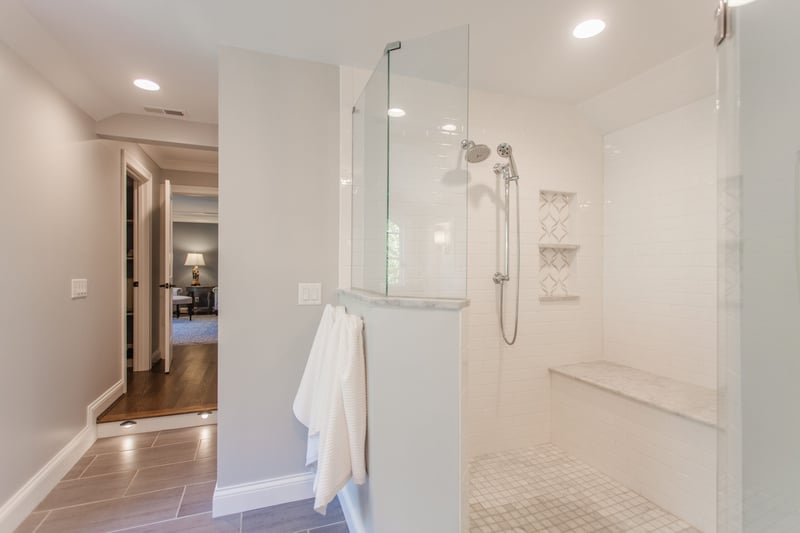How to Create a Multi-Generational Home
A single-family home is not always the move. Multigenerational homes are becoming increasingly popular as families seek smarter, more inclusive living solutions. We love to remodel for parents moving in with adult children, grown kids returning home, or extended relatives sharing a space. A multi-generational home offers countless benefits, from shared expenses to stronger family connections.
Legacy Builders Group designs and builds spaces that stand the test of time and work for all family members. What do you need to know about designing a multi-generational home? You’ll find it all here.

Multi-Generational Home Renovation Basics
What is a Multi-Generational Home?
A multi-generational home is designed to accommodate multiple generations of a family living under one roof while maintaining privacy and independence for everyone. Common layouts include separate living areas, shared kitchens, and dual master suites. These designs promote both connection and autonomy, ensuring all family members feel comfortable and supported.
Benefits of Multigenerational Living
- Cost Savings: Families can share housing expenses, utilities, and even groceries.
- Improved Caregiving: Aging parents or young children can receive care without outside assistance.
- Increased Property Value: Adding features like an ADU (Auxillary Dwelling Unit) can boost your home’s resale potential.
Exploring ADU Types and Configurations
Auxillary Dwelling Units (ADUs) are one of the most versatile solutions for creating a multi-generational home. Whether you’re looking for a private living space for aging parents, a comfortable setup for adult children, or even a future rental opportunity, choosing the right type of ADU is the first step.
Attached ADUs
An attached ADU is connected to your primary home, typically sharing one or more walls. These units are often an addition with a private entrance, a full bathroom, and a kitchenette or small kitchen.

Benefits
- Cost-Effective: Since attached ADUs can share existing utilities like plumbing, electrical, and HVAC systems, construction costs are typically lower than detached options.
- Convenience: Residents enjoy proximity to the main home, which can be particularly helpful for caregiving or shared household responsibilities.
Challenges
- Privacy Concerns: Shared walls may limit soundproofing, and the proximity could feel less independent for some occupants.
- Space Usage: Adding an attached ADU might require reconfiguring or expanding your home’s current layout, which could affect your living area.
Detached ADUs
A detached ADU is a completely separate structure, often built in a backyard or other available space on your property.
Benefits
- Maximum Privacy: Detached ADUs create a fully independent living space, ideal for family members who value privacy or for potential rental income.
- Flexibility in Design: These units offer more design freedom, allowing you to create a unique and fully functional home.
Challenges
- Higher Costs: Detached ADUs require separate utilities and foundation work, leading to higher construction expenses.
- Space Requirements: You’ll need adequate outdoor space to accommodate a detached structure while meeting zoning and setback requirements.
Garage Conversions
Turning an existing garage into an ADU is a popular choice for homeowners looking to maximize their current space without adding a new structure.
Benefits
- Budget-Friendly: Garage conversions are often more affordable since the primary structure already exists.
- Efficient Use of Space: If you don’t use your garage for vehicles, converting it can create a highly functional living area.
Challenges
- Limited Size: Most garages have a smaller footprint, which could restrict design options.
- Retrofitting Costs: Adding insulation, plumbing, and natural light to a garage can require significant work.
Basement ADUs
If your home has a basement, transforming it into an ADU can be a smart and efficient solution.

Benefits
- Integrated Design: Basement ADUs allow you to use your home’s existing structure while creating a separate living area.
- Privacy with Accessibility: Adding an outside entrance to the basement ensures privacy for residents while maintaining access to the main home.
Challenges
- Natural Light: Basements often lack sufficient windows, so incorporating natural light becomes a critical design element.
- Moisture Control: Proper waterproofing and ventilation are essential to prevent dampness and maintain air quality.
Universal Design for Accessibility
When creating a multi-generational home, ensuring accessibility for all ages and abilities is essential. Universal design principles prioritize functionality and ease of use, making the space safer and more comfortable for everyone. Whether accommodating aging parents or small children or planning for your future needs, these features can enhance your home’s usability without sacrificing style in every area of your home.
Key Universal Design Features to Include
- Wider Doorways and Hallways: Allow easy access for mobility aids like wheelchairs or walkers.
- Curbless Showers and Grab Bars: Create safer, slip-resistant bathrooms with modern, streamlined designs.
- Single-Level Living Options: Minimize stairs to ensure ease of movement throughout the space.
- Universal Design Kitchen Features: Opt for pull-out shelves, adjustable countertops, and appliances with front-mounted controls.
- Universal Design Bathroom Enhancements: Include comfort-height toilets and lever-style faucet handles for improved accessibility.

Infrastructure Considerations
Infrastructure is a critical factor when adding an ADU or designing a multi-generational home. Proper planning ensures that the new space operates efficiently and independently while keeping utility costs manageable. Your design-build contractor will help you make the best possible selections for your new living space.
Separate Plumbing, Electrical, and HVAC Systems
Why It Matters
Separate systems allow for better control, privacy, and efficiency. For example, residents in an ADU can manage their own heating, cooling, and water usage without impacting the main home.
Planning Tips for ADU Utilities
Work with experienced professionals to design systems that meet local codes and provide long-term reliability. This might include adding a dedicated breaker box or running new water lines.
Energy Efficiency Upgrades
Incorporating energy-saving technologies into your ADU can reduce utility bills and environmental impact. Consider these options:
- Smart Devices: Don’t heat or light empty rooms. Conserve energy with devices like smart thermostats and lights.
- Tankless Water Heaters: Provide on-demand hot water with lower energy usage.
- Energy-Efficient Insulation: Keep the space comfortable year-round while reducing heating and cooling expenses.
Designing with Future Uses in Mind
One of the greatest advantages of creating a multi-generational home is its adaptability. While your current goal may be to provide living space for family members, designing with flexibility ensures your investment serves a variety of needs over time.
Key Design Strategies for Long-Term Use
- Flexible Layouts: Opt for open floor plans or movable walls that allow spaces to be reconfigured as needed.
- Separate Entrances: These provide privacy now and make the space ideal for future uses, such as a rental unit or guest suite.
- Multi-Functional Rooms: Design spaces that can transition easily. For example, an ADU might start as a rental but later become a home office or studio.
FAQs About Creating a Multi-Generational Home
Are multigenerational homes a good idea?
Absolutely! Multigenerational homes offer many benefits, including shared living expenses, closer family bonds, and the ability to provide care for aging parents or young children. They also increase the flexibility and functionality of your property, making it a worthwhile investment.
How big should a multi-generational home be?
The size depends on the number of residents and their needs. Key factors include separate living areas, bedrooms, and shared spaces like kitchens or dining areas. The goal is to balance privacy with communal living, which doesn’t always require a massive footprint if the layout is efficient.

How can I create privacy in a multi-generational home?
Consider separate entrances for ADUs, soundproof walls, and designated private spaces like bedrooms or sitting areas. Universal design principles, such as strategic layouts and flexible room configurations, can enhance both privacy and functionality
Do you Need a Permit for an ADU?
Understanding local zoning laws, setback requirements, and permit regulations is crucial when creating a multi-generational home. Many areas have specific rules for adding an independent living space within your property.
- Zoning Laws: Check whether your area allows ADUs and under what conditions.
- Setback Requirements: Ensure your new structure complies with distance rules from property lines or neighboring buildings.
- Permits: Most ADU projects, including garage conversions or basement remodels, require building permits.
Design-Build Multi-Generational Remodels in Cincinnati
A multi-generational home is more than just a living arrangement—it’s a thoughtful solution that supports family connections, enhances independence, and provides lasting flexibility. Whether you’re adding an ADU, remodeling for accessibility, or planning for future uses, Legacy Builders Group is here to help. Contact us today to explore your vision and start building a home that truly works for everyone.


